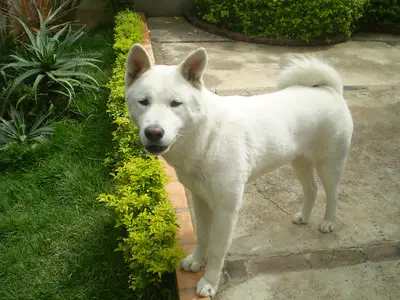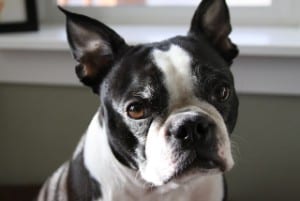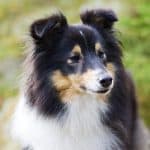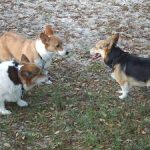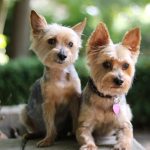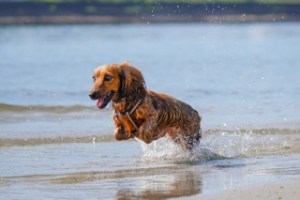
When someone mentions a long-bodied dog, most people automatically picture the quintessential Wiener dog – tiny legs, floppy ears, and soulful eyes. But what about the other long-bodied dogs, like the Bassets, Corgis, and little known Drever?
And, why were they bred to have such long bodies? In this article, we unpack the reason behind the long body and cute little legs, and we explore some long-bodied canines. Let’s dive in.
Why were dogs bred to have long bodies?
Many dogs with long bodies also have long legs. These are sighthounds, used to hunt by sighting the prey (usually large deer) and physically chasing it down using their incredible speed. So, here, the long bodies balance the long legs, offering speed and agility.
Other long-bodied dogs are small, scrappy hunters with short legs, like the Dachshund. These hunting dogs were bred to follow badgers and other small prey into their burrows. It’s also easier to follow a small Corgi than a gigantic Greyhound when hunting on foot or on horseback. Now, those stubby little legs don’t offer much wriggle room when squaring off with a cornered badger, so here, our fierce hunter’s long body provides an advantage. The elongated body offers good heft to win this fight. Here, our four-footed friends have a low center of gravity and enough weight to thrust at its opponent, forcing it off balance and allowing canine triumph.
These hunters’ long bodies also allow for easy access to badger and raccoon burrows while keeping their feet firmly planted on solid ground. Here, the human hunter can easily pull the dog from the burrow by its tail if it needs help.
Interestingly, the long-bodied trait came about accidentally through a genetic mutation that subsequently proved useful.
Now, let’s check out some of these exceptional dog breeds.
[1] Dachshund
Dachshunds are the smallest dogs expressly bred for hunting. These ferocious little predators can wiggle into the tightest burrows with ease since their long bodies are flexible. Dachsies have floppy ears that trap scent molecules, making it super easy for them to sniff out their prey (or your bag of treats). Combine that with their paws meant for digging and sharp nails and teeth, and you’ll understand why they’re such excellent hunting dogs.
[2] Corgis
Corgis were initially bred for herding. These loyal dogs make for excellent pets that are affectionate, but not too needy. Known as a big dog in a small dog’s body, these fearless athletes are speedy and agile, built for long hours of hard work. Keep them healthy with daily walks or slow jogs. When they’ve spent all that energy, they’ll be less likely to get up to mischief.
These lively family dogs come in various colors, including red, fawn, sable, black, and tan. Some also have white markings on their coats. Their thick, waterproof double coat, unfortunately, means lots of shedding, especially during shedding season. That makes for tons of grooming, while regular baths help keep all this hair in check.
[3] Basset Hounds
These laid back family dogs were initially bred for hunting small game, like badgers and rabbits. Since Basset Hounds are so laid back, they probably won’t initiate exercise. So, if you don’t take your pup for a daily walk, he’s likely to become an overweight couch potato. Bassets are big dogs in small bodies, but they still believe that they’re lap dogs, so prepare for some cuddles.
While Bassets shed quite a bit, they’re relatively easy to groom, so your home won’t be too inundated with hair. Their tri-color coats are smooth, short, hard-textured, and usually a combination of white, tan, and black. Some Bassets have an open red and white pattern (red spots on a white coat) or closed red and white (solid red with white feet and tail), or lemon and white pattern.
Bred as hunting dogs, Bassets have a keen sense of smell, second only to Bloodhounds.
[4] Dandie Dinmont Terrier
Dandies were named after Dandie Dinmont, a fictional character invented by Sir Walter Scott, a Scottish author. They’re the only dog breed named after a fictional character.
These wilful, proud hunters sport thick, silky white hair and long, hanging ears. Their body coat ranges from pepper (bluish-black to silvery gray) to mustard (reddish-brown to pale fawn). Don’t be fooled by the Dandie’s short stature, though. These are courageous hunting dogs with a “big dog” bark. When they’re not working, they make excellent family dogs since they love playing with the kids but aren’t as hyper as other small breeds.
While Dandies don’t shed (yay!), they still need daily grooming to strip the dead hair from their coats and keep them looking sharp. They also need tons of exercise – chasing a ball in the backyard or going for a brisk walk. Keep in mind that these are keen hunters, so if your Dandie isn’t on a leash or in a securely fenced off area, he might make a run for it if he spots anything that looks like prey.
[5] Drever
The Drever is a Swedish hunting dog bred to drive deer over challenging terrain. This loyal, even-tempered pup is tough and muscular, built for hard work. You don’t need to put in too much effort to keep this medium-sized pooch looking sharp – the occasional bath is all it takes to keep its short, coarse coat in check. The Drever’s coat ranges from white and sable through to brindle and fawn, or even red. They can also be tri-colored or have white markings on an otherwise solid coat.
When you offer your Drever a balanced daily routine with lots of stimulating exercise, it will easily cuddle on the couch with you as you catch up on Netflix.
[6] Westphalian Dachsbracke
The Westphalian Hound, also known as the Westphalian Dachsbracke, is the ancestor breed for the Drever. Cool, right? Unfortunately, this lovely breed isn’t widely recognized by kennel clubs, even in its home country. That means that you’ll have to do some digging to find a pure-bred pup. While the untrained eye could mistake this pooch for a Dachshund, you’ll notice that the Westphalian’s chest is narrower and its legs longer than the Dachsie’s.
Its gorgeous short fur is usually a tricolor combination of red and yellow with a black saddle and white Bracken marks. That’s what they call the white muzzle, chest, legs, collar, tail tip, and blaze on the head.
[7] Basset Bleu de Gascogne
The rare Basset Bleu de Gascogne, or Gascony Basset, hails from the Middle Ages and nearly died out in the early 19th century. This scent hound with its floppy ears and sad, soulful eyes owes its name to its bluish appearance, caused by a white ticked coat. This smooth coat has characteristic brown or tan spots above the eyes and ears.
The Gascony Basset was bred for slow, steady hunting, easily followed on foot. That said, it still requires lots of exercise to stay healthy and happy.
[8] Basset Fauve de Bretagne
This scruffy-looking, fawn-colored pup is a serious hunter and excellent companion dog. What a combo! The Basset Fauve de Bretagne or Fawn Colored Brittany Basset is small, rough-coated, and hardy. This pup needs a ton of exercise – it’s way too smart and energetic to be a couch potato. It will probably get up to mischief if you don’t let it burn off that energy.
While the Brittany Basset doesn’t require a ton of grooming with its wiry, dirt-repellent coat, you should give it a weekly brush with a fine-toothed comb to keep him looking sharp. And then there’s the seasonal shedding when the weekly brush becomes a daily affair.
[9]American Hairless Terrier
No hair? No fair! This gritty, courageous terrier is ideal for those poor dog lovers that suffer from allergies. Some varieties of the American Hairless Terrier does have hair, though. Weird. And, the hairless ones could have whiskers and eyebrows. Their smooth skin comes in so many beautiful colors, usually in colored spots on a solid white or lemon base.
While hairless dogs mean no shedding and no allergies, brace yourself for some other complications, like sunburn and lots of shivering in cold weather. Since it has no protection against the elements, the American Hairless Terrier isn’t suitable for hunting.
You can recognize this spunky, loyal breed by its broad, wedge-shaped head and erect, V-shaped ears, paired with that characteristic terrier alertness in their eyes. They’re super protective of their human parents, and they’ll let you (and all the neighbors) know if anything moves in your yard.
Closing Thoughts
Dogs with long bodies were initially bred for hunting, usually as scent hounds, but sometimes as sighthounds too. Their agile bodies can wiggle into tiny spaces, like badger and rabbit burrows, and they’re usually slow enough to follow on foot. Some long-bodied breeds, unfortunately, have medical complications linked to their elongated bodies. Regardless of your chosen long-bodied breed, you’re likely to find an alert, energetic pup that’s super loyal and intelligent. Heck, they even come in hairless varieties suitable for allergy sufferers.

